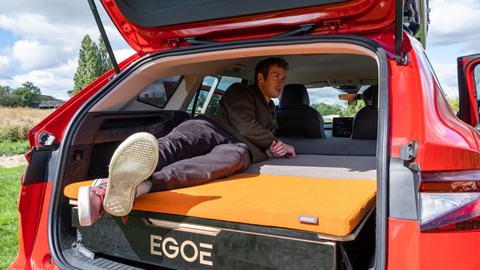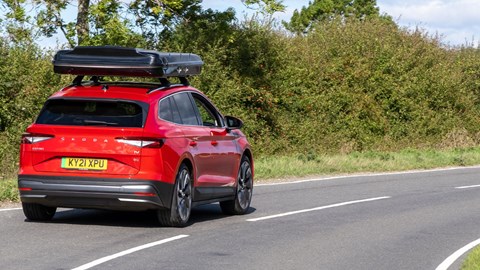- Custom Skoda Enyaq goes camping
- Testing current EV versatility
- Is an EV up to the demanding task?
The best stories are ones where unexpected things play out. Therefore you must be thinking that something drastic must have happened to us while taking a Skoda Enyaq on a recent camping trip. In giving you a spoiler, nothing extreme happened. Rather, we undertook this idea with a nerdy hypothesis in mind.
The premise was to find out if EVs have reached a point where they are versatile enough to be used for something as demanding as camping. Don’t roll your eyes, camping is demanding on cars because they need to have good range, be practical, comfortable, full of entertainment, and ideally engaging for the driver. In some cases, they also need to tow a caravan.
What EV were you using?
We weren’t towing anything behind, we had our mobile accommodation up top. The Skoda Enyaq we were using is a one-off special called the FestEVal. It’s fitted with a roof tent, deconstructed rear seat bed, and custom-made pullout kitchen in the boot. Other than that, it’s a standard Enyaq iV 80 (201bhp, 77kWh battery, 333-mile range).

Rooftop tents are very popular at the moment. They’re more than just being a great set for Instagram, they give you the pros of campervans and tents, with almost none of the cons. They’re lightweight and affordable like regular tents; rooftop tents are also very convenient and off the ground, like campervans.
Where did you take the Enyaq FestEVal?
Yorkshire Dales. It’s nice up there with its mixture of rich pastures and barren moors. But crucially, there are those narrow, winding Postman Pat-style lanes that we considered prime testing ground for the Skoda.
We pointed out how impressive the suspension setup is in our road test of the Enyaq, and even with the extra 60-odd kilograms of weight on the roof, the verdict still stands. A key ally here is the Enyaq’s height. Skoda calls it an SUV, but it isn’t really. In reality, it’s lower and more like an estate car. This helps keep the centre of gravity lower and the wallowing in check.

Be in no doubt, you know you’re driving a 2.1-tonne car (plus camping additions) but provided you’re driving smoothly, it’s very pleasant.
However, what isn’t pleasant is always being close to stone walls. The Enyaq is almost as wide as a Range Rover and on many of the UK’s scenic rural roads, such as the one our camping ground was on, that’s annoying. It meant that on four occasions we had to choose between kissing an overgrown bush on the left or scraping an oncoming car on the right. It was an easy choice of course, but it meant we often wished the Enyaq was a little more like the Citroen Ami.
There’s a lot of onboard tech to keep you comfy and safe, but the best addition for road trips and camping is Android Auto/Apple CarPlay. Ditch the mediocre own brand sat nav and use Google Maps instead.
How was camping with an EV?
The Enyaq has a decent range of up to 333 miles, but it’s not big enough that you can take off anywhere without considering how you’ll recharge it. Somewhere relatively remote like the Yorkshire Dales isn’t awash with charging stations yet. And at the time of writing, there aren’t any rapid chargers.

The consequence is that you need to go out of your way to top the car up, and it’ll take a long time to do so with mostly 7kW chargers available. Thus, we decided to leave the car parked up most of the time and checked out much of the local area on foot. That’s fine if you like walking and hiking, but less so if you prefer bouncing around looking at ruined abbeys and stopping at old inns.
A potential remedy to this is investing in a portable EV charging cable that has multiple adaptors for different socket types and can handle faster charging. They exist and come from brands such as Juice Technology, but they’re very expensive.

Looking on the bright side, the Enyaq returned excellent economy while running around the Dales. With undulating, worming roads and a 60kg box on the roof, this might come as a surprise. But EVs are happier at up to 50mph than at motorway speeds, and at 30 to 55mph, the extra drag from the collapsed tent wasn’t too significant. Throw ample opportunity for energy recuperation into the mix and the Enyaq performed very well indeed. And luckily, the temperature was mild, so range wasn’t affected by this either.
Is an EV a good camper, then?
From the perspective of its usefulness as a homely space to call your own – yes. But, while EVs have become incredibly useful for urban driving and even commuting, they’re maybe less ready for more far flung pursuits without some compromises. The issues are still range and charging. Long wait times compared to a petrol pump and limited range mean you have to do a lot of compromising, meaning it may be smoother for you right now to have to find places to go that suit the EV, rather than going exactly you want.
As battery technology improves, these problems will evaporate. But for now, a Skoda Superb would’ve been preferable.